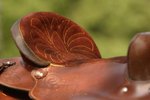Leather saddles need to be cleaned of mold, which can quickly erode and destroy the leather surface of the saddle. Mold also can cause an infection on the horse if it makes contact with the animal's skin. There are specific ways to remove mold off of saddles.
Remove All Parts Outside
Take your saddle apart, bring it outdoors (when it is not wet or raining) and prepare to clean it. This will keep the mold's spores from landing and infecting other leather saddles or objects in the stables. Use old rags to wipe down the moldy areas on the saddle itself; be sure to throw the rags away after you do this to stop the spread of mold. Wipe off as much of the mold as you can with these damp old rags, scrubbing a bit when you do this.
Leather Cleaners
Old manuals about saddles will advise using rubbing alcohol or vinegar to kill the mold on saddles. While this is effective it can also seriously damage or stain the leather. These days, specific pH-neutral cleaning solutions are available to spray on leather and kill mold and mildew growth. Spray these on and then, after a minute or so, wipe away the moldy area. Allow the leather pieces of the saddle to dry out entirely in the hot sun.
Condition the Leather
Once you have gotten rid of the mold on your saddle and the leather has fully dried, it is important to condition the leather so no more mold will grow. Do not use saddle soap, as the moisture from doing this helps give mold or mildew a foothold to begin growing again. Instead, use a neutral pH-based product which will lubricate the leather but not allow organic matter to begin growing. Consistent conditioning, cleaning and upkeep of the saddle after each time you use it--especially when it has been raining or is wet outside--will reduce the chances of mold.
References
Writer Bio
Hailing from Austin, Texas, Daniel Westlake has written under pen names for a myriad of publications all over the nation, ranging from national magazines to local papers. He now lives in Los Angeles, Calif. but regularly travels around the country and abroad, exploring and experiencing everything he can.





